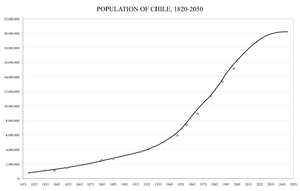This is an old revision of this page, as edited by 200.123.143.74 (talk) at 18:13, 19 November 2005. The present address (URL) is a permanent link to this revision, which may differ significantly from the current revision.
Revision as of 18:13, 19 November 2005 by 200.123.143.74 (talk)(diff) ← Previous revision | Latest revision (diff) | Newer revision → (diff)
Demographics of Chile. Around 95% of Chileans descend from early Spanish colonists, and although the majority possess Native American ancestry in varying degrees – thus deeming them mestizos – very few Chileans would admit their Native American admixture.
Native Americans number around 700,000 and are mostly Mapuche that reside in the south-central area of the country. Aymara and Quechua populations live along the northern border with Peru and Bolivia. There are also some people of Polynesian ancestry who are indigenous to the Chilean territory of Easter Island (Rapanui) in the Pacific.
Chileans descended from non-Spanish European nationalities are not numerous, but include a small yet influential number of English immigrants that arrived in Chile during the Spanish colonial period. Government-sponsored immigration from Germany began in 1848, and in time, changed the cultural makeup of the southern provinces of Valdivia, Llanquihue, and Osorno, which still show a strong German influence. Other immigrant groups include people of Italian, Croatian, and Middle Eastern backgrounds.
In the last decade there has been an influx of Koreans who settled in small sections of Santiago. In recent years, the difficult economic situtation in neighbouring Peru has resulted in work-related trans-Andean migration to Chile.
Chile's population distribution is about 85% urban, with 40% of these living in the greater Santiago de Chile area. The relatively small Central Valley, where Santiago is situated, dominates Chile in terms of population, agricultural resources, and political power. The Central Valley represents Chile's historical center from which it expanded during the late 19th century, integrating the northern and southern regions into its sphere of influence.
Demographic data
Population
- 15,980,912 (July 2005 est.)
Age structure
- 0-14 years: 25.2% (male 2,062,735/female 1,970,913)
- 15-64 years: 66.7% (male 5,320,870/female 5,342,771)
- 65 years and over: 8% (male 534,737/female 748,886) (2005 est.)
Median age
- Total: 30.07 years
- Male: 29.17 years
- Female: 31.05 years (2005 est.)
Population growth rate
- 0.97% (2005 est.)
Birth rate
- 15.44 births/1,000 population (2005 est.)
Death rate
- 5.76 deaths/1,000 population (2005 est.)
Net migration rate
- 0 migrant(s)/1,000 population (2005 est.)
Sex ratio
- At birth: 1.05 male(s)/female
- Under 15 years: 1.05 male(s)/female
- 15-64 years: 1 male(s)/female
- 65 years and over: 0.71 male(s)/female
- Total population: 0.98 male(s)/female (2005 est.)
Infant mortality rate
- Total: 8.8 deaths/1,000 live births
- Male: 9.55 deaths/1,000 live births
- Female: 8.01 deaths/1,000 live births (2005 est.)
Life expectancy at birth
- Total population: 76.58 years
- Male: 73.3 years
- Female: 80.03 years (2005 est.)
Total fertility rate
- 2.02 children born/woman (2005 est.)
HIV/AIDS
- Adult prevalence rate: 0.3% (2003 est.)
- People living with HIV/AIDS: 26,000 (2003 est.)
- Deaths: 1,400 (2003 est.)
Nationality
- Noun: Chilean(s)
- Adjective: Chilean
Ethnic groups
- Mestizo 93%, Amerindian 3%, European 2% other 2%
Religions
- Roman Catholic 89%, Protestant 11%, Jewish NEGL%
Languages
- Spanish
Literacy
- Definition: age 15 and over can read and write
- Total population: 96.2%
- Male: 96.4%
- Female: 96.1% (2003 est.)